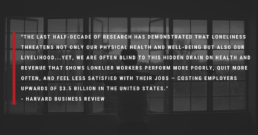Food Is Medicine
--> SIGN UP TO ATTEND <--
Join us as JA hosts our next Journey+ event featuring panelists from Preventia Group. This session will tackle the important conversation on the medicinal qualities of food and how food impacts your health.
During this session you will gain actionable insight on :
- - Defining how food is medicine
- - How to tackle this, together
- - The IMPACT of food
Walk away from this session with a deeper understanding and be ready to take action within your organization by joining us on May 18th at 10a ET.
Recognizing Loneliness and Implementing Solutions
Loneliness: The Epidemic You Can Do Something About
Loneliness in America’s workers is on the rise and you may be surprised to learn that this epidemic began long before the current Covid-19 crisis. But how, in a world seemingly more connected than ever before, can we begin to unravel the cause for the disconnect, feelings of isolation, and impact on mental, emotional, and physical well-being that loneliness has on the average American.
Over the last few years, many prominent universities and research institutions have invested significant effort into discovering the factors contributing to this phenomenon and how to address it in the workplace. One such study highlighted in the Harvard Business Review {America’s Loneliest Workers, According to the Research} caught the attention of expert Olivia Ash, Esq., MS creating a passion and a commitment to research, educate and better understand the impact of loneliness on the legal and other professions, as well as come to understand how to implement effective solutions.
Olivia Ash, Esq, MS, joins JA Benefits this Friday for an important conversation focused on helping HR Professionals and Business Leaders become Advocates for Emotional Well-Being where she will help employers and business leaders Recognize Loneliness and Implement Solutions in the workplace.
Olivia Ash, Esq., MS, brings fifteen years of teaching & management experience to well-being education. After receiving her BS in Exercise Science and MS in Physical Education, Olivia spent a decade advising employers on wellness program management. As an Indiana-licensed attorney, Olivia serves as Associate General Counsel for The Capstone Group, specializing in ERISA compliance for benefit plans. In addition, Olivia is an award-winning writer, researching the experience of loneliness. As an experienced educator, holding an Indiana state teaching license, Olivia serves as Adjunct Faculty at the Indiana University School of Health and Human Sciences.
2020 has been a challenging year for almost everyone and almost every industry. To compound the already researched factors contributing to loneliness, we now have the added forced growth of remote workplaces and quarantines, which contributed to added emotional, physical, mental, and financial stressors. As HR Professionals and Business Leaders, there is the new and extremely heavy burden of shouldering the responsibility of keeping employees safe and healthy, while keeping businesses productive and profitable, often in the face of not feeling equipped with the knowledge or information to be able to do so effectively.
According to the Harvard Business Review, “Loneliness should be as important to managers, CFOs, and CEOs as it is to therapists. The last half-decade of research has demonstrated that loneliness threatens not only our physical health and well-being but also our livelihood. Research shows that loneliness has the same effect as 15 cigarettes a day in terms of health care outcomes and health care costs. Yet, we are often blind to this hidden drain on health and revenue. Lonelier workers perform more poorly, quit more often, and feel less satisfied with their jobs — costing employers upwards of $3.5 billion in the United States.” Interestingly, the outcome of this study illuminated consistent results regardless of industry and across a broad range of demographics revealing, “Lonelier workers reported lower job satisfaction, fewer promotions, more frequent job switching, and a higher likelihood of quitting their current job in the next six months. Feeling a lack of workplace social support was associated with similar negative business outcomes. The economic impact of loneliness is indeed staggering.”
Based on these and other studies, we have come to understand that loneliness is crippling workplace productivity. It impacts every level of your organization, including you. A study of over 20,000 workers by Cigna additionally revealed a worrisome trend that loneliness is contagious. Cigna’s research showed, “Lonely workers take twice as many sick days and demonstrate less commitment and weaker performance. Their emotions can spread to others, as well, causing a ripple effect throughout an organization.” The results of these studies present a clear and loud call to action for our nation’s HR Professionals and Business Leaders.
On November 13th at 9 am, JA Benefits will hold an educational engagement at no charge for HR Professionals and Business Leaders who desire to understand the role they play in implementing workplace solutions for loneliness.
JA recognizes the tremendous weight the current workplace climate could put on even the best Business Leaders and HR Professionals who may not have the insight to recognize the signs of loneliness for the maintaining of their own well-being, much less the well-being of those in their charge. This creates the unnecessary risk of loneliness permeating our organizations and our employee populations. For this reason, JA Benefits is taking steps to lead this conversation by hosting the expert insight of Olivia Ash of Liv Balanced, LLC aiming to provide actionable insight on the loneliness phenomenon for HR Professionals and Business Leaders.
What do the statistics say about how loneliness impacts your health, work, and outlook?
According to the outcome of two Cigna studies, one from 2018 and one from 2020, {Cigna US Loneliness Index – Survey of 20,000 Americans Examining Behaviors Driving Loneliness in the United States, Loneliness and the Workplace – 2020 US Report}, loneliness impacts every area of our daily life touching on all six areas of well-being (emotional, intellectual, occupational, physical, spiritual and social). Drilling down into these survey results, the statistics are staggering and should drive us all to seek a better understanding to recognize the signs and implement solutions.
Your Health:
Studies show there is a 26% increase in the likelihood of mortality among individuals who feel lonely, with an even great (45%) increased risk in seniors. (HRSA, US, 2019).
Your Occupation:
The Cigna studies revealed 32% of men and 23% of women feel abandoned by coworkers when under pressure, while 35% feel a general sense of emptiness at work and 39% feel like they have to hide their true self at work. Lonely workers say they are less engaged, less productive, and report the desire to change jobs more often and leave current employers seeking a better work environment. The statistics for remote workers are even more staggering with over 54% (versus 45% of in-office workers) feel that their relationships with others are not meaningful with 57% of remote workers saying they always or sometimes feel lonely (versus 52% of in-office workers feeling this way).
Your Income:
According to a YouGov survey conducted in 2019, income is a contributing factor to loneliness, but the statistics reveal that loneliness doesn’t seem to vastly discriminate based on income with 58% of people earning less than $40k/year always feeling lonely vs 52% in the $40-$80k/year, and 47% of people earning over $80k/year feeling lonely.
Your Race:
Studies have consistently shown that loneliness permeates every economic and social demographic, and continues to show this non-discrimination when factoring in race with 52% of whites feeling lonely, 47% of blacks, and a staggering 64% of Hispanics reporting feeling lonely.
What about Loneliness and Social Media?
Designed to keep us connected near and far, the advent of social media brought long lost friends and far-away family back into our lives. However, over this past year, more and more experts are sounding the alarm on the negative impact social media is having on our societal need to connect (MIRL) with other human beings versus simply a virtual connection. In other words, clicking ‘like’ or ‘retweeting’ a post from a friend while scrolling through endless memes or TikTok videos for a laugh, is not the same as meeting in person over a cup of coffee for real conversation, encouragement, and connection. Unfortunately, trends show we are doing more of the 'clicking' and less of the 'connecting'. We are quickly becoming a world of very lazy, disconnected, lonely communicators, which is resulting in a significant and negative impact on our well-being. According to the same Cigna study from 2020, they found that 73% of heavy social media users feel lonely versus 52% of light social media users. In addition, a UK study from 2018 found that when social media is used to escape social interaction, it increases loneliness.
Combatting Loneliness in the Workplace
“Given the pernicious effects of loneliness… and given the amount of time people spend at work, leaders must address the issue,” Sigal Barsade, a professor at The Wharton School, told the Society for Human Resources Management (SHRM). “This is not only, of course, because it's an alienating and upsetting experience for the employee, but also because it's an organizational problem.”
Organizations across the country began to invest heavily in workplace culture throughout 2019 and 2020, quickly recognizing that the investment paid off in droves when it came to productivity and retention. Establishing a culture that makes everyone feel welcomed and integrated is action item number one, but any HR professional or business leader can tell you that goal is far from simple to implement and sustain. Creating cultural buy-in across small and large organizations, encouraging participation in meaningful workplace interactions, and addressing factors such as personality differences, demographic differences and life composition differences in your employee population are extremely challenging. Add Coronavirus into the mix and you have yourself a formidable challenge.
Investing time in educating yourself on the loneliness epidemic, understanding contributing factors to loneliness, and learning to recognize the signs of loneliness in your workplace will all help you to better implement solutions. Experts also recommend Business Leaders and HR Professionals take three decisive actions immediately to stem the spread of loneliness in the workplace.
Connect – For Real. In Person.
Technology is our friend. It makes life easier (most of the time). However, it seems the more we adopt new technology to lessen our load and streamline our processes, the more we lessen face-to-face interactions. Given that Cigna highlighted that the “frequency of one’s in-person interactions is a key indicator of how lonely they are” tells us that continued ‘automation’ and ‘streamlining’ could create a bit of a ‘rob Peter to pay Paul’ type scenario in the workplace. A {Future Workplace Study} surveying over 2,000 managers and employees across 10 countries revealed that more than half of an employee’s day is spent using technology to communicate, resulting in a feeling of disconnect and loneliness.
Dan Schawbel, author of Back to Human: How Great Leaders Create Connection in the Age of Isolation, said: “Technology has created the illusion that workers are connected when in reality they feel isolated, lonely, disengaged and less committed to their organizations when overusing or misusing it… Today’s leaders need to use technology as a bridge to connection so that they can foster strong work cultures, where employee’s human needs are met and supported.”
Schawbel went on to share that the best way to combat the negative impacts of the increasing use of technology contributing to feelings of loneliness is through “team building activities, social events and workations where workers can get to know each other on a personal level.” “Having those [personal] connections is one of the strongest predictors of employee satisfaction, retention, performance, and success,” said Rajiv Kumar, a medical doctor and president of Virgin Pulse Institute. “This study underscores the need for us to help our employees by fostering human interaction, communication, and strong relationships that extend past the workplace.”
Culture – Build it. Stick to it.
Corporate culture plays an integral role in employee loneliness. Harvard Business Review described a study that found a culture of “companionate love,” including expressions of affection, caring, compassion, and tenderness among employees, “weakens the negative relationship between workplace loneliness and affective commitment to the organization.” A culture of anger, on the other hand, strengthens it. This may seem like common sense, but many business leaders do not invest the time or resources necessary to define and construct a meaningful workplace culture, which could lead unwittingly to erosion of productivity and increasing feelings of loneliness in their employee population. Leaders should, therefore, encourage a culture of companionship — which, in turn, will help to foster cooperation over competition.
Take Action – Be Intentional.
Loneliness is on the rise, and, unfortunately, the trends of technology, increase in remote workplaces and even the current Coronavirus pandemic contribute to and will continue to contribute to an increase in loneliness unless HR professionals and business leaders take intentional actions with mitigation in mind. Simply recognizing that loneliness exists and can be caused by workplace practices is a good first step, but not enough. Besides millennials and Gen Zers, who may be more reticent to initiate the face-to-face interactions they desperately need, two populations that deserve additional leadership attention are remote workers and new hires. According to Cigna, both of these groups are more likely to feel alone and lack companionship.
New Hires: To reduce loneliness for new hires, leaders should introduce interventions as early as the onboarding process. Christina Zurek, a researcher at ITA Group, suggested “team lunches, snacks near the new person’s desk, or assigning a ‘work buddy’ to show the ropes.” “These early opportunities for social engagement,” she wrote, “help new hires make connections sooner.”
Remote Workers: To reduce loneliness among remote workers, Schawbel suggested letting them lead virtual meetings, utilizing video conferencing software, and having them work on-site regularly. (A Gallup poll found that remote employees who work at the office once per week are the happiest.)
Workplace Design: Contrary to popular belief and workplace design trends, open offices are not the answer. One study found employees spent four fewer hours per day interacting with their colleagues when they transitioned to open offices, as they replaced that vital face time with 56% more emails and 67% more instant messages. “[O]pen office plans don't actually increase collaboration or decrease loneliness,” Susan Cain, author of Quiet, told SHRM. “On the contrary, they create giant rooms full of worker bees wearing headphones.”
So, while the world is changing around us and the future of work will inevitably continue to drive innovation and change, what humans naturally need has not changed. We need other humans. Most company leaders understand that for the company to truly be successful, then the people within the company need to be successful as well. This means the epidemic of loneliness infiltrating our HR professionals, business leaders and employees is well worth addressing while working together to develop solutions and sharing ideas on what is working.
Productivity and profit aside, contributing to the reduction of loneliness in the workplace, contributes to the well-being of us all.
Join us this Friday, November 13th, at 9 am for our complimentary special event, Advocate for Emotional Well-Being: Recognizing Loneliness and Implementing Solutions, featuring expert Olivia Ash, Esq. MS, of Liv Balanced LLC.
Just 28% of Americans expect to return to the workplace before 2021
Although returning back to workspaces seems to be on the top of many minds, many are not sure or uneasy about the idea of returning to a public environment to work, when remote work has become their new normal. Read this blog post to learn more.
Just 28% of Americans say they already have or expect to return to workplaces before the end of the year, indicating the coronavirus pandemic is making remote work more mainstream, a Conference Board survey showed Thursday.
Nearly one-third of respondents said they would be uncomfortable getting back to offices, shops and factories, while half said their greatest concern was contracting the disease at work, according to the Sept. 16-25 online survey of more than 1,100 workers. Only 17% of employees said they were very comfortable or even wanted to return.
The coronavirus continues to spread across the U.S., with 34 states recording higher seven-day averages of new cases compared with a month ago. While progress is being made on a vaccine, it will be months before it’s available to the general public. Even when it is ready, the Conference Board’s survey showed just 7% expect a return to their workplace.
“For knowledge workers and others where remote working is an option, you’re going to see more of a remote or hybrid working arrangement become the standard way,” said Rebecca Ray, executive vice president of human capital at the Conference Board.
A cultural shift to working from home and the pause or stop in business reopenings have upended the commercial real estate market. Federal Reserve Bank of Boston President Eric Rosengren warned that a resurgence in the virus could lead to troubles in the financial sector via commerical real estate.
The “commercial real estate sector is going to be impacted in the long term as we now need much less space for offices, retail, and probably higher education,” said Gad Levanon, head of the Conference Board Labor Markets Institute.
The Conference Board’s survey echoed with a recent poll of company executives by Cisco Systems. More than half plan to downsize their offices as remote working will become commonplace after the pandemic subsides, according to the Cisco survey.
The Conference Board survey also showed that lower-ranking employees are more concerned about returning. Some 20% of rank-and-file workers and 21% of front-line managers indicated they feel pressure to return in order to keep their jobs, compared with just 4% of executives. Individual contributors are also the least comfortable coming back to job sites.
Some 29% of respondents said they had little faith that their colleagues would adhere to safety protocols and guidelines upon return. One-third questioned the wisdom of going back to workplaces because they said productivity has remained high when working remotely, the survey showed.
SOURCE: Ren, H. (15 October 2020) "Just 28% of Americans expect to return to the workplace before 2021" (Web Blog Post). Retrieved from https://www.employeebenefitadviser.com/articles/just-28-of-americans-expect-to-return-to-the-workplace-before-2021
3 ways to support workplace well-being during COVID-19
In a world where well-being is being challenged by employees due to the various complications that the COVID-19 pandemic has placed in their lives, it's important for employers to support and help where they can. Read this blog post to learn more.
Personal and professional worlds are colliding in ways that have never been seen before, leading employees and employers to navigate new challenges in uncharted waters. As employees continue to struggle with balancing work and personal obligations at home, they are dealing with emotional, physical and financial consequences from the pandemic. Some of these struggles will remain even after social distancing measures are lifted and the economy stabilizes, and they could have a lasting impact on people’s overall wellness.
While many companies are rightfully focused on the bottom line and maintaining business operations throughout the pandemic, it is equally important that they take steps to ensure their employees are supported throughout this tumultuous time. Employee well-being is directly tied to business health, which is why it is so important for organizations to optimize their benefits and deliver the right health and wellness offerings for their workers.
Reassess employee benefit programs
The pandemic is raising awareness that total wellbeing, not just physical health, is a key component to success for businesses and the economy. Employees that are facing at home pressures or feeling financially insecure may be less productive or distracted during the workday, which can impact company success. COVID-19 has hit companies hard. Many are looking for places to trim costs, but benefits and wellbeing programs are not an area they can afford to cut.
Diabetes, depression, mental health and financial stress are on the rise with the majority of employees dealing with unprecedented challenges like childcare, caring for family members who are sick or otherwise impacted by COVID-19 and general anxiety about their future. Cutting benefits programs now may save a few thousand dollars today only to spend tens of thousands of dollars on healthcare costs tomorrow.
Employers who understand the value of employee benefits programs will fare much better than those that guess which programs will be effective. This is an ideal time for businesses to re-assess their current well-being offerings to ensure the programs they are investing in align with the needs of their workforce. It’s also essential that employers make sure employees are aware of the wellness offerings available to them and how to use them. Therefore, it’s important for businesses to increase their communications to employees around wellbeing programs that can help provide physical, mental and emotional support through the pandemic and beyond.
Evaluate current and future employee needs
Not all people are the same, which is why one-size-fits-all programs fail. A successful well-being program should be personalized to best meet employees’ current and future needs. This can be difficult, especially when considering environmental and lifestyle factors, but with the right partner it can be done effectively. Many large employers are working with a partner that leverages social determinants of health data such as household composition, purchasing habits, education and income level and more, to identify individual employee needs.
Employers should also evaluate new types of resources to accommodate the “new normal”. Case in point: we have seen double digit increase in engagement with financial wellbeing and EAP resources. Telehealth and remote condition management programs are on the rise as well as stress management and resilience programs. For example, “Linda” has diabetes, so she needs to know the COVID-19 risks associated with her condition. She may also need extra support to ensure she is keeping up with her healthy eating and exercise regimen during quarantine. Connecting her with a remote diabetes program like Livongo or Virta Health can help Linda feel valued and stay on track. Or, “Tom” has been having severe back pain and his doctor recommends he have surgery to correct a spine-related issue. But not all health systems are offering elective surgeries right now, so he is better off with a telehealth pain management program like Telespine or Hinge Health, Physera and Simple Therapy.
This information allows employers to personalize the health and wellness plans they offer to employees and provide them with the right tools to make their healthcare journeys easier as they navigate this new way of life. Employers will also see the benefits in healthier, happier employers, increased productivity and potentially lower long-term healthcare costs.
Have a solid strategy for returning to work
COVID-19 return to work programs will require an increase in spending for heightened safety measures, such as enhanced cleaning and disinfection practices, employee daily temperature checks (which are now required by some states) and developing and implementing policies and procedures that address preventing, monitoring for and responding to an emergence or resurgence of COVID-19 in the workplace.
As businesses begin reopening workspaces, it is critical for leaders to have a solid employee engagement plan in place to keep workers safe. Be sure to clearly and effectively communicate new safety protocols to employees, so they can feel safe going to work as offices reopen. Invite employees to discuss any concerns they may have in an open forum or via a survey and involve them in problem-solving. Listen to their needs both personally and professionally as our lives will be complicated for months, and possibly years to come. It sounds cliché to say that people are companies most valuable assets. However, it could not be more true right now. It’s time for businesses to make employees’ wellbeing a priority and step up to the challenge of evolving their programming to meet current and future needs. Both the business and its employees will benefit.
SOURCE: Hinkle, C. (19 August 2020) "3 ways to support workplace well-being during COVID-19" (Web Blog Post). Retrieved from employeebenefitadviser.com/opinion/3-ways-to-support-workplace-well-being-during-covid-19
Benefits fair cancelled? 6 strategies for remote benefits communication
Even as states begin to reopen from COVID-19-related closures and many employees return to their places of work, employers can’t rely on past approaches to communicate benefits information during open enrollment and to educate employees about their benefits. It’s unlikely that employers will be hosting large events like benefits fairs, a staple of open enrollment in past years, soon. In addition, some employees may continue to work remotely for an extended period, which means in-person benefits communication can’t be the only strategy.
Employers can consider several alternatives to craft an open enrollment and benefits education and engagement strategy that addresses these issues. For many employers, the solution will be to combine several of these approaches to ensure they are effectively communicating important benefits information and providing employees with more than one way to learn about their benefits and get answers to any questions that may arise.
Before developing a strategy, consider surveying employees to find out how they would prefer to receive information about benefits. Some people find email or printed materials effective, others prefer videos or interactive webinars, while others may be more responsive to receiving information via text message. Once you know your employees’ preferences, you can tailor your approach to increase the likelihood that your employees will use the tools you provide and have a positive experience.
- Recast your benefits fair as a virtual event. If you want to gather employees together and explain benefit options, how the open enrollment process will work this year and provide them with the opportunity to interact with benefit vendors, you could create a virtual event modelled on the in-person benefits fair. Depending on your organization’s size, the number of employees you need to reach, and where they are located (for example office employees, warehouse or field employees, and remote employees), your approach to hosting a virtual benefits fair will vary. A growing number of IT service vendors offer virtual event planning and execution services that include setting up the technology needed to conduct the event, handling invitations and registrations of participants, working with benefits vendors to set up virtual booths and arranging educational webinars as part of the event.
- Use your employee intranet, portal, or app. Regardless of whether you host a virtual event, you can use your employee website, portal or app and upload all the informational and educational material employees will need to make benefit choices. This approach can also include a secure portal that employees use to complete benefits forms. Another good feature to include is a chat, which can be either live chat or a chatbot, where employees can get answers to frequently asked questions and assistance with completing open enrollment forms.
- Host webinars. Webinars not only give you the ability to communicate information about benefits, they also give employees the chance to directly ask the HR and Benefits team questions. In addition to the live webinar, you can record the event and post it on your organization’s employee site or send a link via email so that employees who were not able to attend can still hear your message firsthand.
- Mail printed materials home. Some employees still prefer to receive benefits and enrollment information and forms in a printed format. It can provide a resource that they can easily refer back to when making their benefits sign up decision. Mailing these materials to employees’ home addresses rather than using your business address ensures that all employees, those who have returned onsite and those who are working remotely, have access to the information they need.
- Use texts and calendar reminders. To help employees stay on top of enrollment deadlines, send text messages and add reminders to their work calendars. Text messages can also be used to send links to more in depth information resources so employees can access information when required.
- One-on-one support is key. Employees are bound to have more complicated or confidential questions about their benefits choices, e.g. the need for information about coverage for cancer treatment or labor and delivery. Providing one-on-one phone and chat support from the HR and Benefits team gives employees a way to get answers to questions they don’t want to ask in a more public forum such as a webinar.
A benefits plan is only valuable if employees are knowledgeable about what benefits they have and how to access them. Many of these approaches can also be used on an ongoing basis to provide education on and drive engagement with benefits so employees and employers both get the most out of their plans.
SOURCE: Varn, M. (27 July 2020) "Benefits fair cancelled? 6 strategies for remote benefits communication" (Web Blog Post). Retrieved from https://www.benefitnews.com/opinion/benefits-fair-cancelled-6-strategies-for-remote-benefits-communication
Navigating the New Normal in International Business Travel
As rules and regulations begin to lift in regards to traveling components, many organizations are looking at what that means for their company and their international business, as well as business that require traveling. Read this blog post to learn more.
What can your company expect in terms of your employees' ability to travel internationally as parts of the world begin to come out of months of lockdown?
And what will the ongoing restrictions and changes in everyday life mean for your company's ability to transfer or hire new foreign national talent in key areas? Only time will tell exactly what will happen, but we are beginning to see patterns and hints of what is to come.
Some countries that have managed to flatten the curve of COVID-19 infections are gradually easing restrictions on freedom of movement and commerce. This is typically being undertaken cautiously and in a multistep fashion. Other countries have been slower to ease travel restrictions. A broad travel ban remains in place in China, and countries in Latin America continue to extend travel limitations with a wary eye on the outbreak in Brazil.
International travel restrictions on freedom of movement are being eased, albeit more slowly than domestic restrictions. We expect that the easing of international travel restrictions will be incremental in nature as the easing of domestic restrictions has been. We also expect that quarantine requirements for arriving travelers are likely to be put into place in many locations, significantly hampering international business travel.
Arriving travelers are also likely to be questioned more closely than in the past regarding their recent travels, health, reasons for visiting and plans for satisfying quarantine requirements. Although the primary purpose of the vetting may be to limit the spread of COVID-19, an unintended consequence may be that the purpose of the visit and whether the traveler has the correct documentation is scrutinized more closely than in the past. If the traveler is attempting to enter to engage in productive or remunerated work—which often includes consulting, commissioning, installing, troubleshooting and, in some countries, even training or audit activities—without the proper work visa, they are likely to be identified and denied entry.
Governmental migration authorities around the world are beginning to either ramp back up where they were operating at limited capacity or to reopen where they were shut down completely. But although many facilities are ramping up and/or reopening, significant backlogs of applications exist. Many government offices and consulates are encouraging or requiring contactless submissions via post or even e-mail.
The New Normal: A Long-Term Perspective
Looking ahead, it is somewhat challenging to predict what will happen in the global immigration space given that we do not yet know how long the pandemic will drag on. The longer it continues, the more different our new global immigration normal is likely to be. What is already clear is that even if a vaccine or effective remedy for COVID-19 is developed, things are unlikely to go back to "normal" as we knew it before the pandemic. So, what will the new normal look like for your company?
Rise in Remote Work—Decrease in Global Mobility
Many companies have discovered the ability to conduct business remotely, including across borders. What used to require an international business trip (with the corresponding time, costs and visas) now takes place via conference call. Where you used to relocate key staff across borders to facilitate teams working together in person, you likely have now discovered that with everyone working remotely, it may not matter whether your newest team member is physically sitting in Canada, China or France.
New Challenges for Essential Travel
Despite the rise in remote work, technology can't replace all short- or long-term global movement of employees. Some work—installing or commissioning equipment, quality control on a production line, testing of systems and more—simply cannot be done via conference call. If your company has employees who must travel for business purposes, those employees will likely continue to encounter quarantine requirements until the pandemic has been resolved. This means your employees traveling for work will need to provide evidence that they will quarantine for 14 days following arrival, before attending their meetings and/or work duties.
In the past, citizens of privileged countries, such as the U.S., have often enjoyed a low level of scrutiny at ports of entry and have been able to avoid issues when traveling for work purposes without a visa. In fact, before the pandemic, your company's employees may have been previously accustomed to traveling to certain countries with just their passport and no visa. Under the new normal, we anticipate that all international travelers will be subjected to increased scrutiny on entry through the destination country's customs and immigration process. This means your employees are more likely to need to secure a visa in advance of any foreign travel. For this reason, it will be important for you to verify immigration requirements with the most recent information well in advance of your employee's planned travel date. After all, the last thing you want is for your employee to experience the unpleasant surprise of being denied entry or prevented from boarding a flight.
New Challenges for Long-Term Relocation and Local Hires
While it is true for some industries that it does not matter whether a new hire is sitting in Canada, China or France, for others, it absolutely matters. It is probably impossible for a manager to supervise a manufacturing facility via Zoom. Unfortunately, it is likely that companies seeking to transfer or hire foreign nationals will face increased hurdles, even beyond the immediate travel-related hurdles posed by COVID-19 travel restrictions. As unemployment numbers have soared, we have already seen a significant political backlash against immigrants in the U.S. Even putting aside any politically or economically motivated reduction of work visa numbers, the labor market reality of having millions of citizens out of work will make it extremely difficult to pursue work visas that require labor market testing. This would include Labour Market Impact Assessment work permits in Canada, Tier 2 General work visas in the U.K., and Subclass 482 work visas in Australia, among others.
Mitigating Negative Impacts: Preparation and Strategy
It is hard to imagine how any company, let alone a company with global operations and travel needs, could avoid the negative impact of the pandemic. Here are a few ways your company can mitigate (rather than eliminate) the negative impacts:
- Raise awareness. Your company and your employees are likely to face many obstacles that you are not accustomed to, whether it is a requirement that employees add 14 days to a business trip to accommodate a mandatory quarantine period, the need to obtain visas in advance of travel where they previously could travel without one, or delaying many months before starting a new position while waiting for a work visa approval. It is crucial that all key stakeholders within your company are made aware that immigration is not business as usual. Stakeholders include not only HR and legal personnel but also company managers and recruiters. To the extent that employees can book international travel without managerial approval, it may be prudent to disseminate policies and information to all employees regardless of level. Requirements for travel, transfer and new hires alike must be checked before business commitments and plans are made or contracts with clients are signed. We recommend providing both written and video training to ensure that managers and other employees outside of legal and HR who may not be familiar with immigration concepts have both an opportunity to ask questions and reference materials to refer to in the future.
- Conduct quarterly planning. In countries where international transfers or hiring of foreign nationals is not prevented by political and labor market challenges, it will be important for your company to plan well in advance for any transfer or new hire. It is likely that the process of obtaining the necessary work visa and/or permit will be slower for some time given the COVID-19-related backlogs. Even where the immigration process itself is not slower than usual, it may take significantly more time to procure the corporate and personal documents (such as birth certificates, marriage certificates and university diplomas) that often must be included in visa applications. It is also possible that there will be more requirements that must be satisfied to obtain the visa, such as medical exams and negative COVID-19 tests. Given this, we strongly recommend that your company plan as far in advance as possible. Although it is not always possible to anticipate all business needs, it is a best practice to work to identify upcoming assignments or new hires on a quarterly basis. We have seen that having a policy and schedule in place with the relevant managers and recruiters can go a long way to reducing last-minute immigration surprises. As part of this plan, before committing to a client contract or signing an employment contract, companies should confirm with their immigration counsel or another trusted source that the employee is able to qualify for the necessary visa and the timeline involved.
- Implement a global mobility management system. While we have always recommended that companies with global mobility needs have an organized way to track and manage the global movement of their employees, the pandemic has greatly increased the need for such a system. Many companies were caught off guard by the fast-moving pandemic and did not know where their employees were in the world, when their visas were expiring or how they were going to get them home again. Having a centralized system will certainly not solve all your problems, but it will at least equip your company with the information and tools needed to make informed decisions. A "system" does not necessarily mean the very latest and most expensive software for managing global mobility, but rather, some sort of functional, organized method by which to vet and track travel, international transfers and new foreign national hires, along with a clear company global mobility policy.
SOURCE: Lustgarten, A. (08 July 2020) "Navigating the New Normal in International Business Travel" (Web Blog Post). Retrieved from https://www.shrm.org/resourcesandtools/hr-topics/talent-acquisition/pages/navigating-new-normal-international-business-travel.aspx
Hand Hygiene
Keep your hands clean to help avoid getting sick and spreading germs to others. Your best option is to wash your hands with soap and warm, clean running water for at least 20 seconds. If soap and water are not available, use an alcohol-based hand sanitizer to clean your hands.
When Should You Wash Your Hands?
- Before preparing or eating food
- After going to the bathroom
- After changing diapers or cleaning up a child who has gone to the bathroom
- Before and after tending to someone who is sick
- After blowing your nose, coughing or sneezing
- After handling an animal or animal waste
- After handling garbage
- Before and after treating a cut or wound
Legislative compliance can be burdensome without the right partner.
JA delivers confidence and clarity in compliance through our on-staff expertise accompanied by a vast selection of resources.
Use our provided resources to stay informed with updated compliance guidelines and regulations - courtesy of JA BENEFITS.

Telemedicine Basics
As technology evolves, doctors are finding more ways to efficiently and conveniently care for their patients. One such method is through the use of telemedicine—a form of technology-based communication that allows a doctor and patient to communicate without being in the same physical space. Although telemedicine is not a complete replacement for direct patient care, it can be a useful tool for a variety of medical services, such as evaluation, diagnosis and prescribing treatment.
How to Prepare for a Telemedicine Appointment
As you prepare for a telemedicine appointment, you should consider several things.
- You will probably need access to a laptop, phone or tablet, as well as an internet connection.
- Because there is physical separation in telemedicine, any information you are able to provide, such as personal medical records
and family medical history, can be helpful to your doctor. - If you are recovering or being cared for at home, it might be helpful to include caregivers in the visit. For many patients, obtaining medical care can cost a great deal in time, resources and money. Telemedicines a service that can help reduce the barriers of time and distance to a hospital or doctor’s office.
How Telemedicine Works
Through the use of technology, communication is facilitated either in a real-time or delayed setting. Usually a patient is able to communicate from his or her home with a doctor through a live video, audio or patient data transfer system. Doctors can see the patient and assess his or her symptoms, as well as obtain the patient’s records and medical history from electronic medical records.
Telemedicine is not a full replacement of the care a patient can receive in a doctor’s office; however, it can provide several benefits.
Patients can stay in the comfort of their own homes and potentially prevent further illness from exposure to germs in a hospital or clinic. Many medical experts believe that patients who have difficulty traveling or who live in a rural area might have an easier time accessing medical care through telemedicine because telemedicine eliminates the need for travel in many situations. In addition, patients who are recovering from illness or injury at home can be monitored by their doctors through telemedicine visits.
While telemedicine can reduce barriers to receiving medical care, there are some limitations. One main restriction on telemedicine is licensing regulations. In some states, doctors are required to have a license in the state in which they physically practice, as well as in the state in which the patient is located. Additionally, doctors are limited in the kinds of care they are allowed to provide to a new or existing patient. For example, the doctor may not be able to treat a new condition without scheduling a faceto-face follow-up appointment.
Legislative compliance can be burdensome without the right partner.
JA delivers confidence and clarity in compliance through our on-staff expertise accompanied by a vast selection of resources.
Use our provided resources to stay informed with updated compliance guidelines and regulations - courtesy of JA BENEFITS.

COVID-19 and the Workplace
Highlights
- COVID-19
The illness caused by the coronavirus can cause symptoms ranging from mild to severe. Cases are expected to spread throughout the United States. - Disease Prevention
Employers must maintain a safe work environment for employees. They may require employees to stay home from work if they are at risk of spreading the disease. - Legal Obligations
Employers must also consider their obligations under workplace laws.
OVERVIEW
As the number of reported cases of the novel coronavirus (COVID-19) continues to rise, employers are increasingly confronted with the possibility of an outbreak in the workplace.
Employers are obligated to maintain a safe and healthy work environment for their employees, but are also subject to a number of legal requirements protecting workers. For example, employers must comply with the Occupational Safety and Health Act (OSH Act), Americans with Disabilities Act (ADA) and Family and Medical Leave Act (FMLA) in their approach to dealing with COVID-19.
This Compliance Bulletin provides a summary of the compliance issues facing employers in this type of situation.
ACTION STEPS
There are a number of steps that employers can take to address the impact of COVID-19 in the workplace. In addition to reviewing the compliance concerns outlined in this Compliance Bulletin, employers should:
- Closely monitor the CDC, WHO and state and local public health department websites for information on the status of the coronavirus.
- Proactively educate their employees on what is known about the virus, including its transmission and prevention.
- Establish a written communicable illness policy and response plan that covers communicable diseases readily transmitted in the workplace.
- Consider measures that can help prevent the spread of illness, such as allowing employees flexible work options like working from home.
What is the Coronavirus?
The 2019 novel coronavirus (“COVID-19” or “coronavirus”) is caused by a member of the coronavirus family that is a close cousin to the SARS and MERS viruses that have caused outbreaks in the past. Symptoms of COVID-19 include fever, runny nose, cough and trouble breathing. Most people develop only mild symptoms. But some, usually people with other medical complications, develop more severe symptoms, including pneumonia, which can be fatal. The incubation period for COVID-19 is from two to 14 days.
Initially detected in Wuhan, China in late 2019, the first case of COVID-19 in the United States was reported on January 21, 2020. Since then, the disease has spread to more than 50 people within the continental United States, with CDC officials warning of further outbreaks.
How is Coronavirus Spread?
The available information about how the virus that causes COVID-19 spreads is largely based on what is known about similar coronaviruses. COVID-19 is a new disease and there is more to learn about its transmission, the severity of illness it causes, and to what extent it may spread in the United States.
According to the CDC, the virus is thought to spread mainly from person to person, between people who are in close contact with one another (within about six feet) or through respiratory droplets produced when an infected person coughs or sneezes. These droplets can land in the mouths or noses of people who are nearby, or possibly be inhaled into the lungs. It may also be possible for a person to contract COVID-19 by touching a surface or object that has been contaminated with the virus and then touching his or her own mouth, nose, or eyes, but this is not thought to be the main way the virus spreads.
People are thought to be most contagious when they are most symptomatic. Some spread might be possible before people show symptoms, and there have been reports of this occurring, but this is not thought to be the main way the virus spreads.
Occupational Safety and Health Act of 1970
Under the federal Occupational Safety and Health Act of 1970 (the OSH Act), employers have a general duty to provide employees with safe workplace conditions that are “free from recognized hazards that are causing or are likely to cause death or serious physical harm.” Workers also have the right to receive information and training about workplace hazards, and to exercise their rights as employees without retaliation.
There is no specific Occupational Safety and Health Administration (OSHA) standard covering COVID19. However, some OSHA requirements may apply to preventing occupational exposure to COVID-19. In addition to the General Duty clause, OSHA’s Personal Protective Equipment (PPE) standards and Bloodborne Pathogens standard may apply to certain workplaces, such as those in the healthcare industry.
Employers should continue to monitor the development of COVID-19 and analyze whether employees could be at risk of exposure. It is also important for employers to consider what preventative measures they can take to maintain safety and protect their employees from potentially contracting COVID-19.
Also, OSHA requires many employers to record certain work-related injuries and illnesses on their OSHA Form 300 (OSHA Log of Work-Related Injuries and Illnesses). OSHA has determined that COVID19 is a recordable illness when a worker is infected on the job. Establishments that are required to complete an OSHA 300 log should be sure to include all COVID-19 infections that are work related.
The Americans with Disabilities Act
The Americans with Disabilities Act (“ADA”) protects applicants and employees from disability discrimination. It is relevant to COVID-19 because it prohibits employee disability-related inquiries or medical examinations unless:
- They are job related and consistent with business necessity; or
- The employer has a reasonable belief that the employee poses a direct threat to the health or safety of him-or herself or others (i.e., a significant risk of substantial harm even with reasonable accommodation).
According to the Equal Employment Opportunity Commission (EEOC), whether a particular outbreak rises to the level of a “direct threat” depends on the severity of the illness. Employers are expected to make their best efforts to obtain public health advice that is contemporaneous and appropriate for their location, and to make reasonable assessments of conditions in their workplace based on this information.
The EEOC has said that sending an employee home who displays symptoms of contagious illness would not violate the ADA’s restrictions on disability-related actions because advising such workers to go home is not a disability-related action if the illness ends up being mild, such as a seasonal influenza. On the other hand, if the illness were serious enough, the action would be permitted under the ADA as the illness would pose a “direct threat.” In either case, an employer may send employees home, or allow employees to work from home, if they are displaying symptoms of contagious illness.
The ADA requires that information about the medical condition or history of an employee, obtained through disability-related inquiries or medical examination, be collected and maintained on separate forms and in separate medical files and treated as a confidential medical record. Employers should refrain from announcing to employees that a coworker is at risk of or actually has a disease. Instead, employers should focus on educating employees on best practices for illness prevention.
Employee Leave Requirements
If an employee, or an employee’s family member, contracts COVID-19, the employee may be entitled to time off from work under federal or state leave laws. For example, an employee who is experiencing a serious health condition or who requires time to care for a family member with such a condition may be entitled to take leave under the Family and Medical Leave Act (FMLA). An illness like COVID-19 may qualify as a serious health condition under the FMLA if it involves inpatient care or continuing treatment by a health care provider. Employees may also be entitled to FMLA leave when taking time off for medical examinations to determine whether a serious health condition exists.
Many states and localities also have employee leave laws that could apply in a situation where the employee or family member contracts COVID-19. Some of these laws require employees to be given paid time off, while other laws require unpaid leave. Employers should become familiar with the laws in their jurisdiction to ensure that they are compliant. Some employees may wish to stay home from work out of fear of becoming ill. Whether employers must accommodate these requests will depend on whether there is evidence that the employee may be at risk of contracting the disease. A refusal to work may violate an employer’s attendance policy, but employers should consult with legal counsel prior to disciplining such an employee. However, if there is no reasonable basis to believe that the employee will be exposed to the illness at work, the employee may not have to be paid for any time that is missed.
Communicating with Employees
As part of their efforts to prevent the spread of COVID-19 in the workplace, employers should consider communicating information about the illness to employees. The CDC, WHO and OSHA have all created informational material on the virus and its symptoms, prevention and treatment that can be helpful for employees.
Legislative compliance can be burdensome without the right partner.
JA delivers confidence and clarity in compliance through our on-staff expertise accompanied by a vast selection of resources.
Compensation and Benefits
If employees miss work due to COVID-19, whether they are compensated for their time off will depend on the circumstances. As noted above, employees may be entitled to paid time off under certain state laws if they (or a family member) contract the illness. In other cases, non-exempt employees generally do not have to be paid for time they are not working. Exempt employees must be paid if they work for part of a workweek, but do not have to be paid if they are off work for the entire week. Note that special rules may apply to union employees, depending on the terms of their collective bargaining agreement.
Employees may be entitled to workers’ compensation benefits if they contract the disease during the course of their employment. For example, employees in the healthcare industry may contract the disease from a patient who is ill. Whether an employee is eligible for other benefits, such as short-term disability benefits, will depend on the terms of the policy and the severity of the employee’s illness.
Use our provided resources to stay informed with updated compliance guidelines and regulations - courtesy of JA BENEFITS.

Coronaviruses and the Workplace
Overview
Coronaviruses are fairly common and don’t typically affect humans. When they do, their effects are usually mild, as in the case of the common cold.
However, deadlier variations of these coronaviruses have cropped up in recent years. Two examples of these evolved strains are the SARS virus of 2003 and the novel coronavirus, which was first seen in 2019. In both instances, the viruses ravaged the populations they infected, illustrating why employers must stay alert to developing outbreaks.
It’s the responsibility of every employer to protect employees from these and other illnesses in the workplace. Taking even small precautions could save an organization countless hours of lost productivity.
Identifying Coronavirus Symptoms
Common coronaviruses typically cause mild to moderate upper-respiratory tract illnesses, and those affected exhibit cold-like symptoms. The most common symptoms include:
- Headache
- Cough
- Fever
- Sore Throat
- Runny Nose
Some cases of coronavirus can be more severe, and individuals experience more serious lower-respiratory tract illnesses like bronchitis and pneumonia. For the elderly, infants and those with weakened immune systems, a coronavirus can be deadly.
Precautions for the Workplace
Employers should protect against coronaviruses much like they protect against the flu: Offer on-site flu shots, stock cleaning wipes and hand sanitizer, and educate employees on prevention methods. Unfortunately, there is no known vaccine for a human-contracted coronavirus, making precaution that much more critical.
According to the Centers for Disease Control and Prevention, individuals should take the following precautions to avoid person-toperson spreading of a coronavirus:
- Avoid touching your eyes, nose or mouth with unwashed hands.
- Avoid contact with those who are sick.
- Wash your hands often with soap and water.
Avoiding Potential Discrimination
As with any workplace policy, employers should be wary of inadvertent discrimination when it comes to a coronavirus prevention policy (e.g., ordering employees home when they seem sick). Just because an employee recently traveled to China and coughed in the elevator doesn’t mean an employer can send them home. Whatever policy a company decides to pursue, it must be equally enforced. Discriminating against employees—or asking illegal health-related questions— can introduce a host of legal concerns.
Summary
Employee education is one of the best lines of defense for a workplace. General preventive health practices, like washing hands, can safeguard workers even when they’re at home. Remind employees to keep up their hygiene and share their knowledge of coronavirus symptoms so they know what to look out for. Together, you and your employees can stay safe, healthy and productive.
Speak with JA Benefits, LLC for more information on staying healthy in the workplace.
Legislative compliance can be burdensome without the right partner.
JA delivers confidence and clarity in compliance through our on-staff expertise accompanied by a vast selection of resources.
Use our provided resources to stay informed with updated compliance guidelines and regulations - courtesy of JA BENEFITS.













